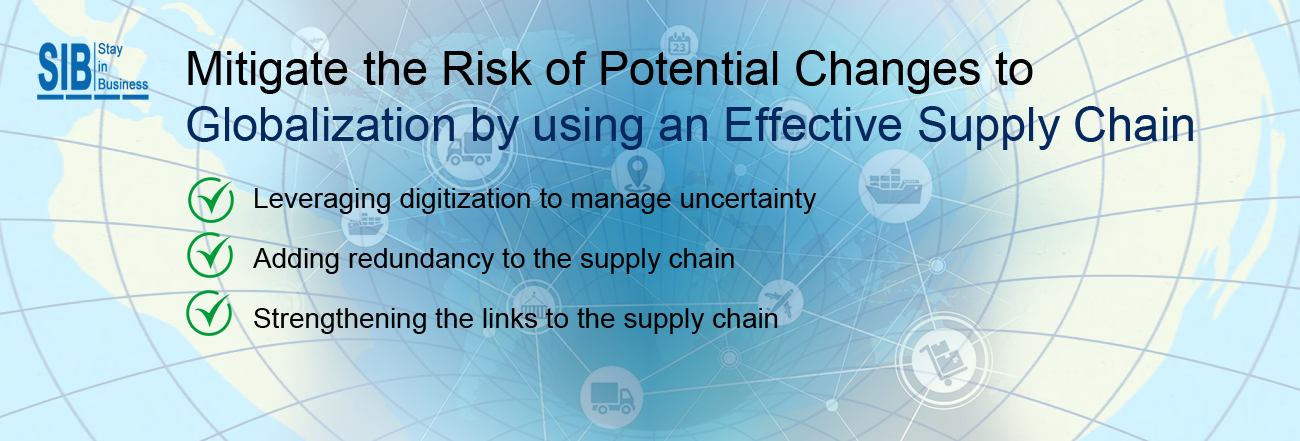How to mitigate the risk of potential changes to globalization

Globalization is changing: How to mitigate the risk of potential changes to globalization?
With remarkable technological progress and rising international cooperation, the world is more connected. There is rising interdependence of the world’s economies. In recent years, the global economy has undergone continuous disruptions. For example, while the United States’ trade war with China affected the U.S. automotive industry to a great extent, the COVID-19 pandemic developed an almost continuous supply chain delay in most of the industries. Moreover, with the energy crisis that started following the COVID-19 pandemic as well as the Russia-Ukraine conflict, there is a big question whether the negativities of globalization have surpassed the positives.
The increasing focus towards safety by multinational companies
Safety is becoming a priority for MNCs besides economic and efficient markets. This is especially a concern, with huge geopolitical challenges comprising climate change, regional overdependence on the supply chain, and the Russian war on Ukraine, the consequences of which disrupted the entire world. This highlights the significance of a global safety net and regional preparations to safeguard economies.
Global ties are augmented by the tremendous advance of technology
Globalization has increased technological diffusion. Both developed and developing economies benefit from the cross-border technological transfer in the form of increased domestic productivity levels. Technology makes cross-border trade more efficient and equitable for small and medium businesses. Even small businesses have begun embracing artificial intelligence. Technological advancements decrease costs of transportation and communication between nations and hence support global sourcing of raw materials and other inputs. Besides the globalization of production, technological innovations have been helpful to the internationalization of markets. Digital technologies allow companies to quickly expand markets around the world.
How companies can mitigate the risks of potential changes in globalization
It is clear that the nature of globalization is changing swiftly given the multiple pressures it undergoes. However, international trade has potential to continue though it may encounter possible risks and may change. Here are few tips to mitigate the risk of potential changes to globalization by using an effective supply chain strategy:
1) Leveraging digitization to manage uncertainty
To handle variability, gather as much data as possible regarding supply and demand and leverage machine learning to provide a sophisticated view of changing conditions over time. The key is the more data the organization collects, the more it can forecast actual demand. Digitizing the supply network enhances visibility and response time when things are not good. Companies can predict and respond to concerns including supplier overcapacity and transport disruptions before they become an overwhelming problem.
2) Adding redundancy to the supply chain
Redundancy in supply chain refers to building or maintaining excess capacity or backup over the total supply chain to maintain day-to-day actions in the case of any unexpected event leading to disruption. Maintaining redundancy as a key part of supply chain should be done, especially in an incremental manner. For instance, approaching new suppliers as capacity expands is safer than making a complete change to the way the whole business sources goods. Also, instead of relying on one vendor for major components or raw materials, collaborate with reliable secondary suppliers and manufacturers.
3) Strengthening the links to the supply chain
- Companies must take into account the whole value chain while taking actions for mitigating risks in their supply chains
- Developing a network of reliable options comprising near-shoring (the process of shifting operations to a nearby country) is crucial
- Companies should concentrate on R&D and innovation to manage the changes in globalization. When there is strong innovation and highly skilled employees, the whole supply chain will stand to gain
- With the trend changing from just-in-time (the inventory arrives just in time before it’s needed) to just-in-case (wherein companies maintain large inventories on hand), the reserve inventory can be expanded. The key is prioritizing readiness over the cost of holding stock
Several organizations refocus on the pathways of global trade and finance. This is more important because these organizations benefit from globalization. The internationalization strategies of organizations would fructify only with a pretty good share of globalization. Still companies can develop closer ties with regional suppliers and enhance the speed to market. The key is even considering the potential of digital globalization while being flexible enough to forces of localization.
Categories: Manufacturing, Safety, Supply Chain
